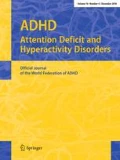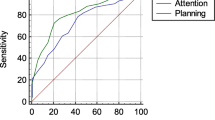Abstract
One of the main aspects of theory of mind is intentionality which refers to recognizing other people’s intentions in their behaviors. The aim of this study was to investigate intentionality in children with attention-deficit/hyperactivity disorder (ADHD). Thirty children with ADHD were compared to thirty age- and IQ-matched normal children. All participants were assessed using the moving shapes paradigm task which contains one large red and one small blue triangle moving around a black screen. They were asked to describe what the movements mean and how the triangles interact with each other. The answers were rated based on the accuracy, type of descriptions applied, mental states, and length of phrases. With regard to intentionality score, children with ADHD performed significantly worse than normal children (P < .05). Based on appropriateness score, the accuracy of patients’ answers was lower in comparison with the control group. Children with ADHD used longer phrases as compared to controls. Children with ADHD can have problems with comprehending others’ intentionality. This leads to impairment in social relationship.
Similar content being viewed by others
References
Abell F, Happe F, Frith U (2000) Do triangles play a trick? Attribution of mental state to animated shape in normal and abnormal development. Cogn Dev 15:761–767
American Psychiatric Association (2000) Diagnostic and statistical manual of mental disorders (DSM-II), 4th edn. American Psychiatric Association, Washington (Text revision)
American Psychiatric Association (APA) (1994) Diagnostic and statistical manual of mental disorders, 4th edn. American Psychiatric Association, Washington
Barkley RA (1997) ADHD and the nature of self-control. The Guilford Press, New York
Barkley RA (2003) Attention-deficit/hyperactivity disorder. In: Mash EJ, Barkley RA (eds) Child psychopathology, 2nd edn. The Guilford Press, New York, pp 75–143
Bruncm M, Brunce-Cohrem U (2005) Theory of mind—evaluation ontogeny, brain mechanism and psychology. Neurosci Behav Rev 30:437–455
Butielaar J, Wees VD, Barneveld HS, Jan vandergaag R (1999) Theory of mind and emotion recognition functioning in autistic spectrum disorders and in psychiatric control and normal children. Dev Psychopathol 11:39–58
Castelli F, Happe F, Frith U, Frith C (2000) Movement and mind; functional imaging study of perception and interpretation of complex intentional movement pattern. NeuroImaging 12:314–325
Castelli F, Frith C, Happe F, Frith U (2002) Autism, Asperger syndrome and brain mechanisms for the attributions of mental states to animated shape. Brain 125:1839–1849
Charman T, Carrol F, Sturge C (2001) Theory of mind, executive function and social competence in boys with ADHD. Emot Behav Diffic 6(1):31–48
Dyck MJ, Ferguosen K, Shochet IM (2001) Do autism spectrum disorders differ from each other non-spectrum disorders on emotion recognition tests? Eur Child Adolesc Psychiatry 10(2):105–116
Faraone SV, Biederman J, Mick E (2006) The age-dependent decline of attention deficit hyperactivity disorder: a meta-analysis of follow-up studies. Psychol Med 36:159–165
Fonseca D, Seugiar V, Santos A, Poinso F, Deruelle CH (2009) Emotion understanding in children with ADHD. Child Psychiatry Hum Dev 40:111–121
Gaub M, Carlson CL (1997) Gender differences in ADHD: a meta-analysis and critical review. J Am Acad Child Adolesc Psychiatry 36:1036–1045
Greene RW, Biederman J, Faraone SV, Sienna M, Garcia-Jetton J (1997) Adolescent outcome of boys with attention-deficit/hyperactivity disorder and social disability: results from a 4-year longitudinal follow-up study. J Consult Clin Psychol 65:758–767
Koelkebeck K, Pedersen A, Suslow T, Kupper KA, Arolt V, Ohermann P (2010) Theory of mind in first episodic schizophrenia patients: correlation with cognition and personality trait. Schizophr Res 119:115–123
Mohammadzadeh A, Tehrani-Doost M, Khorrami-Banaraki A (2012) Evaluation of theory of mind (intentionality) in primary school children using movement shape paradigm. Procedia Soc Behav Sci 32:69–73
Nigg JT, Quamma JP, Greenberg MT, Kusche CA (1999) A two-year longitudinal study of neuropsychological and cognitive performance in relation to behavioral problems and competencies in elementary school children. J Abnorm Child Psychol 27:51–63
Nijmeijer JS, Minderaa RB, Buitelaar JK, Mulligan A, Hartman CA, Hoekstra PJ (2008) Attention-deficit/hyperactivity disorder and social dysfunctioning. Clin Psychol Rev 28(4):692–708
Perner LJ, Lang B, Kloo D (2002) Theory of mind and self-control: more than common problem of inhibition. Child Dev 73:752–767
Polanczyk G, Rohde LA (2007) Epidemiology of attention-deficit/hyperactivity disorder across the life span. Curr Opin Psychiatry 20:386–392
Shamay-Tsoory SG, Aharon-Peretz J (2007) Dissociable prefrontal networks for cognitive and affective theory of mind: a lesion study. Neuropsychologia 45(13):3054–3067
Sodian B, Hulsken C, Thoermer C (2003) The self and action in theory of mind research. J Conscious Cogn 12:777–782
Spencer TJ (2006) ADHD and co morbidities in childhood. J Clin Psychiatry 67:27–31
Sprong M, Schothorst P, Vos E, Hox J, Van Engeland H (2007) Theory of mind in schizophrenia: meta-analysis. Br J Psychiatry 191:5–13
Tehrani-Doost M, Noorazar G, Shahrivar Z, Khorrami A (2012) Facial emotion recognition in boys with attention deficit hyperactivity disorder. Neuropshyciatrie 60(5):S272–S273
Acknowledgments
This study was a part of the first author’s thesis in obtaining M.Sc. in Cognitive Sciences at the Institute for Cognitive Science Studies. We thank all children and their parents for their contribution to this study.
Author information
Authors and Affiliations
Corresponding author
Ethics declarations
Conflict of interest
There is no conflict of interest for none of the authors.
Rights and permissions
About this article
Cite this article
Mohammadzadeh, A., Tehrani-Doost, M., Khorrami, A. et al. Understanding intentionality in children with attention-deficit/hyperactivity disorder. ADHD Atten Def Hyp Disord 8, 73–78 (2016). https://doi.org/10.1007/s12402-015-0187-9
Received:
Accepted:
Published:
Issue Date:
DOI: https://doi.org/10.1007/s12402-015-0187-9




